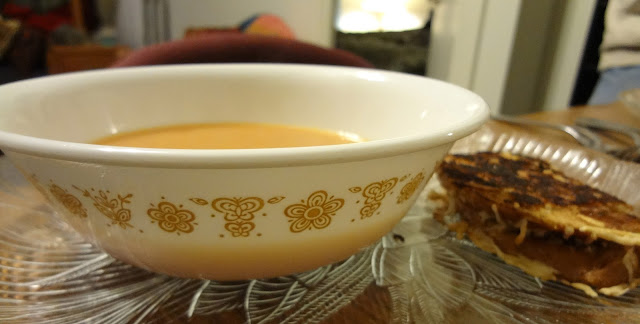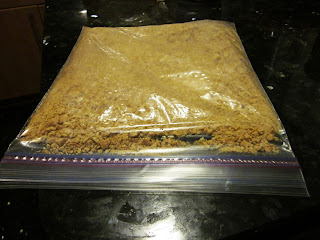 |
| Figure 1. Tomato Soup |
Although the year is new, the winter is not. It's cold and dark (but not much snow!) We wanted to make something simple and warm, just enough to bring us back from the winter doldrums. We chose a simple tomato soup.
We dream to eventually cook a fancy and complex soup, with roasted and pureed vegetables, something that takes more than a couple steps. However, it's winter, and it was a long day, so we decided to push our dreams off for some other day. How's that for a cheerful, uplifting thought?
 |
| Figure 2. Our NFPA Ratings for tomato soup. |
Prep time: One hour and 20 minutes. Most of that time is spent dicing tomatoes and cooking. The steps in between don't take up much time. The recipe claimed it would take much less time than it actually did.
Difficulty: 5. The recipe was a bit confusing. Maybe our reiteration of the recipe will knock this rating down a point or two, but we want to report our experiences as they happened. (Get ready to read about some weird soup.)
Course: Dinner or lunch, but it needs to be paired with a main course. We suggest grilled cheese.
 |
| Figure 3. Simmering the Diced Tomatoes |
Tomatoes - 4 cups, diced (Figure 3)
Onion - 1 slice
Cloves - 4 whole
Chicken Broth - 2 cups
Butter - 2 tbsp
All-Purpose Flour - 2 tbsp
Salt - 1 tsp
White Sugar - 2 tsp (or to taste)
Methods
1. In a stockpot, over medium heat, combine the tomatoes, onion, cloves, and chicken broth
2. Bring to boil, and gently boil for about 20 minutes to blend all of the flavors.
3. Remove from heat and run the mixture through a food mill into a large bowl or pan.* Discard leftover bits from the food mill.
4. In the stockpot, melt the butter over medium heat.
5. Stir in the flour to make a roux,** cooking until the roux is a medium brown.
6. Gradually whisk in a bit of the tomato mixture, so that no lumps form, then stir the rest.
7. Season with sugar and salt, and adjust to taste.
*We used a strainer and mashed it through. Big mistake. (See Results)
**A roux is a homemade thickening agent that is common in French cooking. Just stir until it is evenly mixed.
Results
Well...okay. Let's talk. It's not like we didn't try. We were just so excited about cooking that we failed to read the recipe closely in advance. If we had, we would have noticed that we needed a food mill. Instead, we skimmed the directions, and as a result, were forced to improvise after we learned of the integral role of this mystical apparatus.
 |
| Figure 4. NOT a substitute for a food mill. |
Coming off of a string of successful cooking escapades, our hubris overcame us, and we thought we could somehow manage without the food mill. We quite mistakenly thought we could mash our tomato mixture through a strainer and get similar results, mostly because we had not idea what a food mill was. Don't try it. It won't work. Basically, 75% of the taste of the soup came from the chicken broth, and only 25% came from the tomato mixture. This happened because more of the tomato was supposed to be blended into the broth. Because of our half-baked idea (pun intended) to substitute a plastic strainer for the raw power of metal blades, the chicken broth remained the dominant flavor in the soup. Put simply, our tomato soup tasted like chicken. Yikes!
That is not to say it did not taste good. It was still rather tasty...but maybe a bit salty. Actually, it only tasted good when we dipped the grilled cheese in it, which toned down the chicken flavor and put the emphasis on fried bread and cheese. Grilled cheese was really our saving grace in this endeavor. This recipe seemed like a lot of work for basic tomato soup, but maybe that's just because we didn't have a food mill.
 |
| Figure 5. Tomato Soup with Grilled Cheese |
Was it worth it? We leave that to you to decide.
Discussion
One ingredient we found surprising and problematic in this recipe was chicken broth. Why would tomato soup use chicken broth? Isn't tomato soup supposed to be a vegetarian dish? Why not just use water? So we decided to look further into the matter.
First of all, do you know what's actually in chicken broth? It's a little gross...you might not want to keep reading. Chicken broth is full of gelatin, which you'll know is made from hydrolyzed collagen if you read our post on thickening agents. Remember the gummy bears? Gelatin is a shared ingredient between chicken broth and gummy bears. Doesn't sound so tasty anymore? Then you should additionally know that collagen can be found in bones, tendons, cartilage, connective tissues, etc (Priest 2010). A vegetarian's nightmare! Good thing neither of us is a vegetarian. Actually, don't get up-in-arms about this apparent travesty just yet. Sources tell us that store-bought chicken broth doesn't contain as much hydrolyzed protein as homemade broth. Yes, you read that right. Store-bought broth has less bones, tendons, cartilage, connective tissues, etc. than the homemade stuff.
 |
| Figure 6. Chicken Broth |
 |
| Figure 7. Vegetable Broth |
Our other question, "Why not just use water?" Well, there seems to be no consensus on that. It could either be great or disastrous. Some people add water to their soup anyways to add more volume to it. The chicken broth camp claims that the bits of tendons and bones and chicken guts boost the soup's flavor (Priest 2010). To be honest though, we did not like that our tomato soup tasted like chicken. It was weird. Next time, we will either get a food mill, or we will just try water.
1. Priest, C. Feb. 2010. "DIY Chicken Stock." Food/Science.
2. May 2008. "Vegetable Broth." Cook's Illustrated.






















